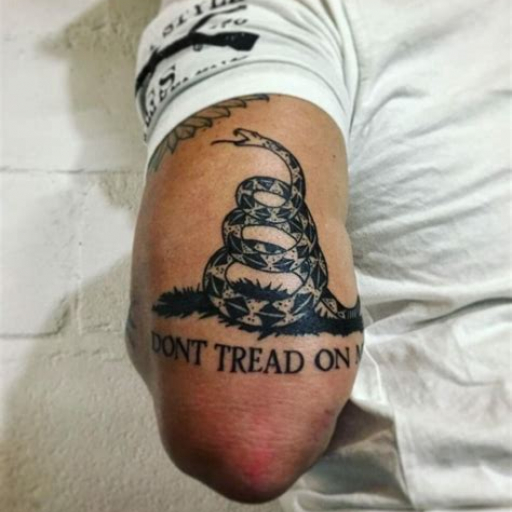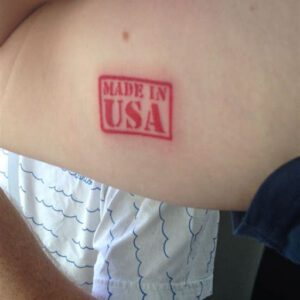The “Don’t Tread on Me” symbol, often associated with the Gadsden flag, has become a popular tattoo design representing freedom, independence, and defiance. Whether you’re a patriot, a libertarian, or simply value your individuality, a “Don’t Tread on Me” tattoo can be a powerful statement of your beliefs.
Symbolism and Meaning
The “Don’t Tread on Me” symbol, depicting a coiled rattlesnake with the phrase “Don’t Tread on Me,” represents the idea of resistance against tyranny and oppression. The rattlesnake, a venomous creature, serves as a warning to potential aggressors to avoid provoking it. Similarly, those who bear the “Don’t Tread on Me” tattoo convey that they will not tolerate being stepped on or infringed upon.

This symbol resonates with individuals who value their independence, autonomy, and the right to live freely without government overreach or external coercion. It represents a strong commitment to defending one’s rights and freedoms, whether on a personal, political, or societal level.
Variations and Designs
The “Don’t Tread on Me” tattoo can be customized to reflect the individual’s style and preferences. Traditional variations include a monochrome design featuring the rattlesnake and phrase in black or gray ink. Alternatively, artists may incorporate color to create a more vibrant and eye-catching tattoo.
The size and placement of the tattoo are also personal choices. Some opt for a subtle design on the wrist, ankle, or behind the ear, while others prefer a larger, more prominent piece on the arm, shoulder, or chest. The positioning of the rattlesnake’s coils can also vary, creating a unique and dynamic composition.
Patriotism and Cultural Significance
Beyond its individualistic meaning, the “Don’t Tread on Me” tattoo has become synonymous with American patriotism. It is often associated with the Gadsden flag, which was flown by early American colonists during the Revolutionary War to symbolize their defiance against British rule.
Today, the “Don’t Tread on Me” tattoo serves as a reminder of the sacrifices made by those who fought for American independence. It represents a deep respect for the Constitution and a commitment to upholding the values of liberty and self-governance.
Modern Interpretations
While the “Don’t Tread on Me” tattoo remains popular among those who embrace its historical symbolism, contemporary interpretations have emerged that relate it to broader concepts of freedom and autonomy. Some individuals choose to incorporate elements of nature into their tattoos, such as mountains, trees, or oceans, as symbols of personal growth, resilience, and the pursuit of adventure.
The “Don’t Tread on Me” tattoo can also be a statement of resistance against social norms or expectations. By embracing this symbol, individuals convey that they will not conform to societal pressures or be dictated to by others. It represents a belief in the importance of individuality, non-conformity, and the freedom to live one’s life on one’s own terms.
Conclusion
The “Don’t Tread on Me” tattoo is a powerful and versatile design that has resonated with generations of individuals who value freedom, independence, and defiance. Whether inked in traditional black and gray or adorned with vibrant colors, this symbol serves as a reminder of the importance of resisting tyranny and upholding our rights.
From its patriotic roots to its modern interpretations, the “Don’t Tread on Me” tattoo remains a significant and meaningful expression of personal beliefs and values.
FAQ
What does the “Don’t Tread on Me” tattoo symbolize?
The “Don’t Tread on Me” tattoo symbolizes resistance against tyranny, oppression, and the infringement of one’s rights and freedoms.
Is the “Don’t Tread on Me” tattoo only for Americans?
While the symbol is often associated with American patriotism, it has gained popularity among individuals worldwide who embrace its message of freedom and independence.
Can the “Don’t Tread on Me” tattoo be customized?
Yes, the “Don’t Tread on Me” tattoo can be customized to reflect personal style and preferences, including size, placement, and the incorporation of additional elements.
Is the “Don’t Tread on Me” tattoo considered offensive?
While the symbol can provoke strong reactions, it is not inherently offensive. However, it is important to be aware of the potential interpretations and context in which it is displayed.
What is the best placement for a “Don’t Tread on Me” tattoo?
The best placement for a “Don’t Tread on Me” tattoo depends on personal preference and the desired visibility. Common choices include the arm, shoulder, chest, and wrist.



